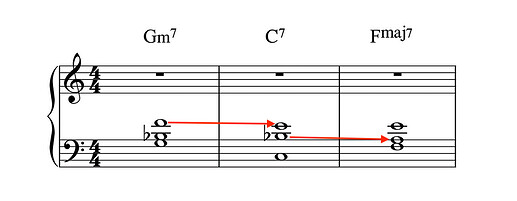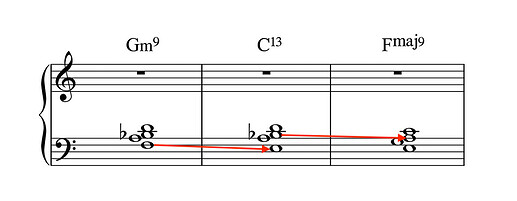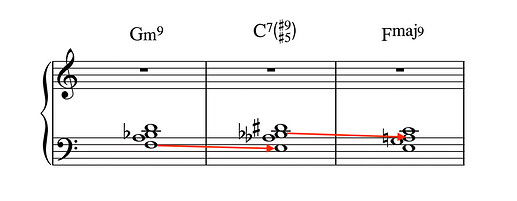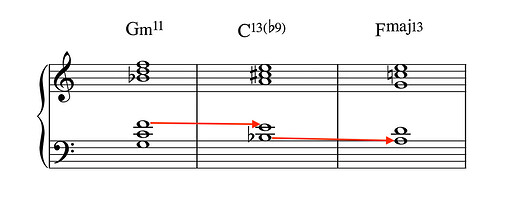Hi Claudio ![]()
Firstly, I had a similar question from a student which I reposted in the forum. You can see it here: How & What To Practice - I’d recommend reading it as it has some pointers you might find useful.
Now to help you with your specific question:
Similar to what I mention in the post referenced above. I found the most effective way to learn was to play as many new jazz standards as possible. This way I was exposing myself to many different keys, many different 25s, 251s etc…
By playing jazz standards, it’s fun way to learn the theory.
Within 251s, you can practice and apply so much different theory topics and concepts:
- major scale
- major modes
- minor scale
- minor modes
- 3 note 251s
- rootless 251s
- extensions
- alterations
- upper structures
- suspensions
- substitutions
Now, something important you need to understand:
In a small number of jazz standards, you can find 251s in pretty much all 12 keys.
Let’s use examples from the standards in the PianoGroove course…
In the first 12 bars of “Tune Up” we have 3 different 251s:
On the first line we have a 251 in D Major:
The second line we have a 251 in C Major:
The 3rd line we have a 251 in Bb Major:
Now that’s 3 of the 12 keys covered already.
If we move onto the next tune, Misty:
On the first line, we have a 251 in Eb Major and a 251 in Ab Major:
Another tune from the beginner courses is “Beautiful Love”
We have a 251 in F Major, on the second line:
Now that’s 6 of the 12 major 251s (half of them!) covered in just 3 jazz standards!
The point is that simply by learning jazz standards, you are covering the theory too. Playing jazz standards is a fun way to learn, and so you should utilise this when learning theory.
Just for fun, let’s find standards with the other 6 major keys we need:
The bridge of “What Are You Doing The Rest Of Your Life”
This contains 251s in the keys of A Major and Gb Major:
Next the first 4 bars of “Laura”
We have a 251 in G Major:
Finally, the first 4 bars of “Body & Soul”:
We have a 251 in Db Major:
That’s 10 of the 12 Major 251s … all in just 6 jazz standards.
There are 2 other 251s that we didn’t find… the keys of E Major and B Major.
These keys, also known as the “bright keys” - because they have a very “bright” sound - they are not as common in the jazz standard repertoire.
Horn players like flat keys - Eb, Bb, F, Db - and so that’s why the majority of jazz standards are written in these keys. These are the keys that you should be most familiar with.
Now onto your questions:
What way could be more fun, than by learning the theory in context of these tunes?
For every 251, as an example, you could create a practice schedule
- Play the chord in your left hand, and the scale in your right hand.
- Learn the scale degrees of each note in the scale
- Learn the 7th chords
- Play the rootless voicings
- Extend up and play R-3-5-7-9 for major and minor chords
- Play through each one and try the b9 over the V7 chord, then the #9, #5 etc…
- Try to find a nice upper structure for each one
- Experiment with sus chords
Now 6, 7, & 8 are getting more advanced but I hope you can see the point.
You sum it up perfectly here:
The jazz standards are the ‘special arrangements/compositions’
They are perfect for it! They have been composed by musical geniuses which is why they are used and loved by all jazz musicians.
The jazz standards contain everything you will need to explore jazz harmony, jazz improvisation, chords, voicings, scales, modes, substitutions… Everything you can imagine, you can do it with the jazz standards!
The next step is to listen…
-
Make a playlist for every jazz standard you learn.
-
Perhaps you can find 10 recordings of each jazz standard
-
Listen to them everyday, study them, and transcribe from them
-
This will do wonders for your playing
A final piece of advice:
A final tip is to spend some time learning the scales numerically first. There is no easy way to do this.
Instead of thinking C-D-E-F-G-A-B-C you must think 1-2-3-4-5-6-7-1
Do this for all keys.
You have not been wasting your time with jazz standards
You should be very proud of that! Jazz is very tricky to learn and so learning 2 arrangments is a big task when just starting out.
That is not wasted time Claudio… you just need to learn more jazz standards.
The more you learn, the more you will understand about harmony.
I hope this helps - I’m happy to answer any more questions you may have.
Cheers.








 lol)
lol)








